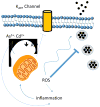Environmental Toxicant Exposures and Type 2 Diabetes Mellitus: Two Interrelated Public Health Problems on the Rise
- PMID: 29392186
- PMCID: PMC5788318
- DOI: 10.1016/j.cotox.2017.09.003
Environmental Toxicant Exposures and Type 2 Diabetes Mellitus: Two Interrelated Public Health Problems on the Rise
Abstract
Rates of type 2 diabetes mellitus (T2DM) are rising rapidly across the globe and the impact of this devastating disease threatens to plague the 21st century. While some contributing factors are well-recognized (e.g. sedentary lifestyles and caloric excess), others diabetes-promoting risk factors are less established or poorly appreciated. The latter category includes environmental exposures to diabetogenic contaminants. Herein we review some of the latest concepts and mechanisms by which environmental exposures may contribute to rising rates of T2DM with a particular focus on mechanisms involving mitochondrial dysfunction and imbalances in reactive oxygen species (ROS). Furthermore, while the pathogenesis of diabetes includes impairments in insulin sensitivity as well as insulin secretion, we will specifically delve into the links between environmental exposures to toxicants such as arsenic and disruptions in insulin release from pancreatic β-cells. Since β-cell death or dysfunction lies at the heart of both T2DM as well as type 1 diabetes mellitus (T1DM), environmental endocrine disrupting chemicals (EDCs) that disrupt the production or regulated release of the glucose-lowering hormone insulin are likely contributors to diabetes risk. Importantly, understanding the contribution of toxicants to diabetes risk as well as improved understanding of their mechanisms of action offer unique opportunities to modulate diabetes risk via targeted therapeutics or public policy interventions to reduce and remediate exposures.
Keywords: Arsenic; Endocrine Disrupting Chemicals; Oxidative Stress; Selenium; Type 2 Diabetes.
Figures


References
-
- Buettner GR. The pecking order of free radicals and antioxidants: lipid peroxidation, alpha-tocopherol, and ascorbate. Arch Biochem Biophys. 1993;300:535–543. - PubMed
-
- Augusto O, Bonini MG, Amanso AM, Linares E, Santos CC, De Menezes SL. Nitrogen dioxide and carbonate radical anion: two emerging radicals in biology. Free Radic Biol Med. 2002;32:841–859. - PubMed
-
- Bonini MG, Consolaro ME, Hart PC, Mao M, de Abreu AL, Master AM. Redox control of enzymatic functions: The electronics of life’s circuitry. IUBMB Life. 2014 - PubMed
-
- Stadler K. Oxidative stress in diabetes. Adv Exp Med Biol. 2012;771:272–287. - PubMed
Grants and funding
LinkOut - more resources
Full Text Sources
Other Literature Sources
